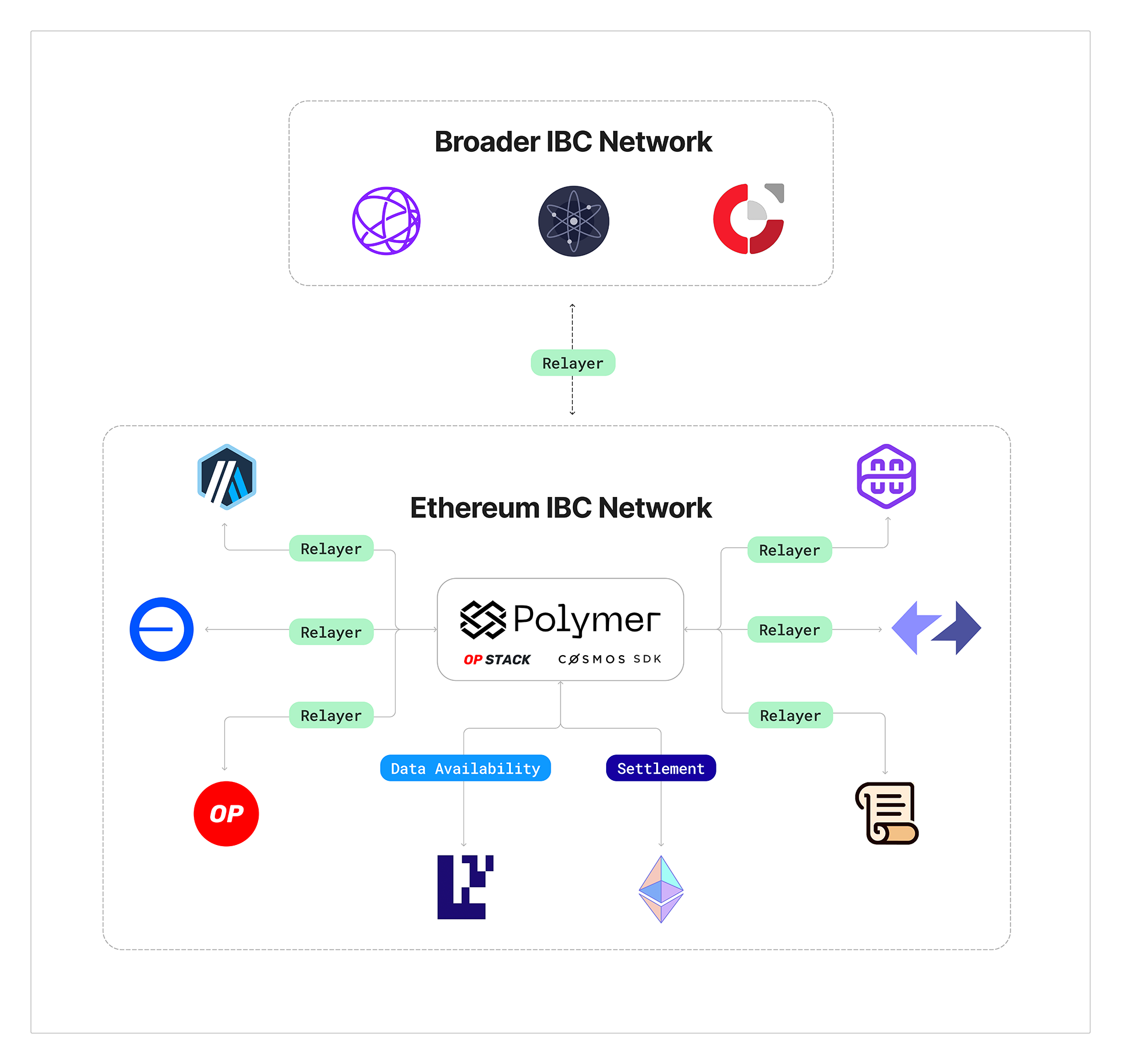Learn how Polymer integrates Ethereum and Cosmos in one article
Original Title: 《Polymer: Ethereum's Interoperability Hub》
Author: Polymer Labs
Compiled by: Elvin, ChainCatcher
TL;DR: Polymer is building an interoperability hub for Ethereum, achieving interoperability between all Ethereum rollups through native IBC technology supported by Ethereum's security.
Polymer itself is an Ethereum rollup composed of the following building blocks:
- Settlement: OP Stack provides settlement and chain derivation logic for Ethereum
- Execution: Cosmos SDK provides native IBC interoperability for connected rollups
- Data Availability: EigenDA provides scalable data availability
- Proofs: The modular fault proof system of OP Stack provides:
- Interactive fraud proofs: Interactive verification games (IVG) played on MIPS (Cannon) or RISC-V (Asteric) fault proof VMs
- ZK validity proofs: RiscZero
Interoperability ------ What Stage Are We At Now?
Since Ethereum launched in July 2015 as the first blockchain to support arbitrary application logic, its extensive community of developers, investors, and enthusiasts has built one of the most powerful networks in the cryptocurrency space. Ethereum has become a fertile ground for experimentation with various types of decentralized applications (from decentralized finance to NFTs, etc.). Moreover, Ethereum not only provides decentralized computing to the world but also offers censorship-resistant currency and a deflationary store of value.
Although Ethereum is the largest and most widely used decentralized network, scalability has been a persistent barrier to growth. However, Layer 2 has partially alleviated the scalability issue and shown progress, especially in how they achieve Web 2 scalability and user experience, but they also come with trade-offs. Sharded execution across these Layer 2s, while achieving scalability, comes at the cost of creating isolated execution environments that fragment liquidity, confuse end users, and complicate developers' journeys.
With no standard native messaging solution across these chains, cross-layer security composability has become one of the most pressing issues plaguing Ethereum, and these issues will continue to grow with the launch and expansion of Layer 2s. Early interoperability solutions attempted to address this by building token bridges, but previous bridges were not secure and were susceptible to massive hacks (see here, here, and here for just a few examples). All existing Arbitrary Messaging Bridges (AMB) are implemented as smart contracts, and different implementations lead to fragmented composability.
How do we solve these issues?
Polymer: Ethereum's Interoperability Hub
With experience building interoperability and cross-chain applications on Ethereum since 2020, the Polymer team is excited to announce our latest design and architecture connecting Ethereum, rollups, and more.
Polymer is not a third-party bridge but a Layer 2 rollup that specifically acts as Ethereum's interoperability hub by providing IBC (Inter-Blockchain Communication) as a feature of Ethereum and establishing connections with integrated Layer 2s. This domain-specific interoperability model improves upon the non-domain-specific approaches adopted by predecessors. Ethereum itself is validating IBC execution on behalf of its rollups. We expect domain-specific interoperability to become increasingly popular in the short term.
Polymer allows applications to have composability across Ethereum rollups and can access the growing network of applications and functionalities provided by IBC, including inter-chain accounts, application callbacks, and more.
Polymer adopts a hybrid approach, combining the settlement capabilities of the OP Stack with the developer experience and native interoperability of the Cosmos SDK. Polymer also leverages Eigenlayer's data availability, scaling Ethereum's network data availability throughput to 10 mb/s and optimizing further.
While Layer 2 is recognizing the necessity of interoperability by building zero-knowledge provers and shared ordering, these efforts are mostly isolated and limited to their own frameworks, only addressing partial interoperability issues. We believe that Ethereum and its rollups lack a unified interoperability standard to address the pain points of each multi-ecosystem stakeholder. Polymer establishes IBC as the interoperability standard for the entire industry.
IBC Build
IBC is a blockchain interoperability solution that allows arbitrary data transfer between blockchains connecting over 100 chains and facilitating over $30 billion in transfers. It is currently the most battle-tested interoperability protocol in the industry. No other interoperability protocol has achieved the scale of IBC, connecting over 100 chains and facilitating over $30 billion in transfers. Recently, it has safely facilitated over $1.5 billion in transaction volume monthly. The design of IBC embodies key attributes that align with the core spirit of blockchain:
- Trustlessly Neutral: IBC is open-source software that anyone can contribute to, rather than a product of any single profit-driven company. It is developed as a public good, with no rent-extracting chains within the protocol, allowing applications and smart contracts to use IBC for free.
- No Vendor Lock-In: IBC allows application protocols to easily switch between security models and interoperability providers. For example, switching interoperability providers does not require reverting and migrating tokens. IBC channel upgrades can switch the underlying connections to new groups, preventing vendor lock-in.
- Modular Security: IBC is designed to ensure the highest standard of default security while allowing developers the flexibility to reduce security for less critical use cases. It can be configured to use consensus-validated light clients, multi-signers, or even native bridging rollups for validation.
- Provides a Robust Feature Set: IBC offers key functionalities that builders need but are not widely used in competing solutions. Developers can not only use IBC to build token transfers but also create inter-chain accounts (i.e., the ability for a module or contract on one chain to control an account on a remote chain), inter-chain queries, and asynchronous communication between smart contracts across different chains. Imagine using a single private key to control wallets across all chains where you hold assets, and how this would simplify the user experience for the average user.

OP Stack Build
Polymer joins a long list of blockchains utilizing OP Stack as their settlement infrastructure, including Base, Zora, and others. We chose to use OP Stack as the settlement framework for Ethereum's interoperability hub because it can provide:
- Flexibility, Scalability, and Performance: What sets Polymer apart from other Rollups is its focus on meeting the interoperability needs of applications on other Rollups rather than executing decentralized applications itself. This divergence from the vast majority of rollup functionalities requires significant flexibility to build. OP Stack also has higher capacity and throughput compared to the Ethereum mainnet, which is necessary to support the interoperable rollup world we envision.
- Decentralization through a Thriving Collaborative Ecosystem: The OP Stack is building a robust network, combining engineering talent from OP Labs, Coinbase, and various open-source contributors to accelerate the decentralized development of the superchain.
- Ethereum Security and Consistency: Ethereum has the right combination of technical, cultural, and economic elements to continue developing the most powerful decentralized ecosystem in the crypto space. Our team at Polymer Labs is committed to advancing Ethereum's scaling roadmap, particularly in scaling interoperability.
Eigenlayer Build
EigenDA uses the same underlying asset to increase the data bandwidth of the Ethereum network to ensure security. Here are the detailed reasons we chose to use EigenDA for data availability:
- Ethereum Security: A domain-specific interoperability hub should borrow as much security as possible from the same source as its connected Rollups. For Rollups inheriting Ethereum's security, the safest choice is to use Ethereum DA. The next best option is to leverage EigenDA, which borrows security from a subset of Ethereum's staking and validator set.
- Scalability: EigenDA significantly enhances the data availability throughput of the Ethereum network. EigenDA's cost model is also more flexible, providing more affordable data availability services to support high-throughput use cases like cross-chain interoperability.
Bringing It All Together
We have carefully selected this approach because we believe IBC is the right solution for the Ethereum ecosystem. As the highest-value settlement layer in cryptocurrency, Ethereum provides the greatest security for cross-chain transactions conducted through Polymer, rather than relying on any alternative solutions that depend on validator sets or blind trust in centralized off-chain entities. With the surge in the number of L2s on Ethereum, the demand for domain-specific interoperability hubs like Polymer is also growing. Polymer also leverages EigenDA to enhance the scalability and cost-effectiveness of the solution.
Polymer plays a key role in Ethereum's scaling story, enabling builders to create seamlessly composable applications across Ethereum rollups and other domains through the best trust models. The interoperable future we are building is the future of cryptocurrency achieving mass adoption. In this future scenario, users can easily store their assets on-chain, leverage the best applications regardless of which chain they live on, and navigate cryptocurrency without complex user experience barriers.
Integrating Ethereum and Cosmos
The values of Ethereum and Cosmos align and establish foundational innovations for blockchain technology. Both have made significant strides in advancing our industry, but they have done so through separate paths. Polymer changes this by establishing a pathway to directly deploy the advancements made in Cosmos into the Ethereum ecosystem, including bringing IBC to Ethereum.










